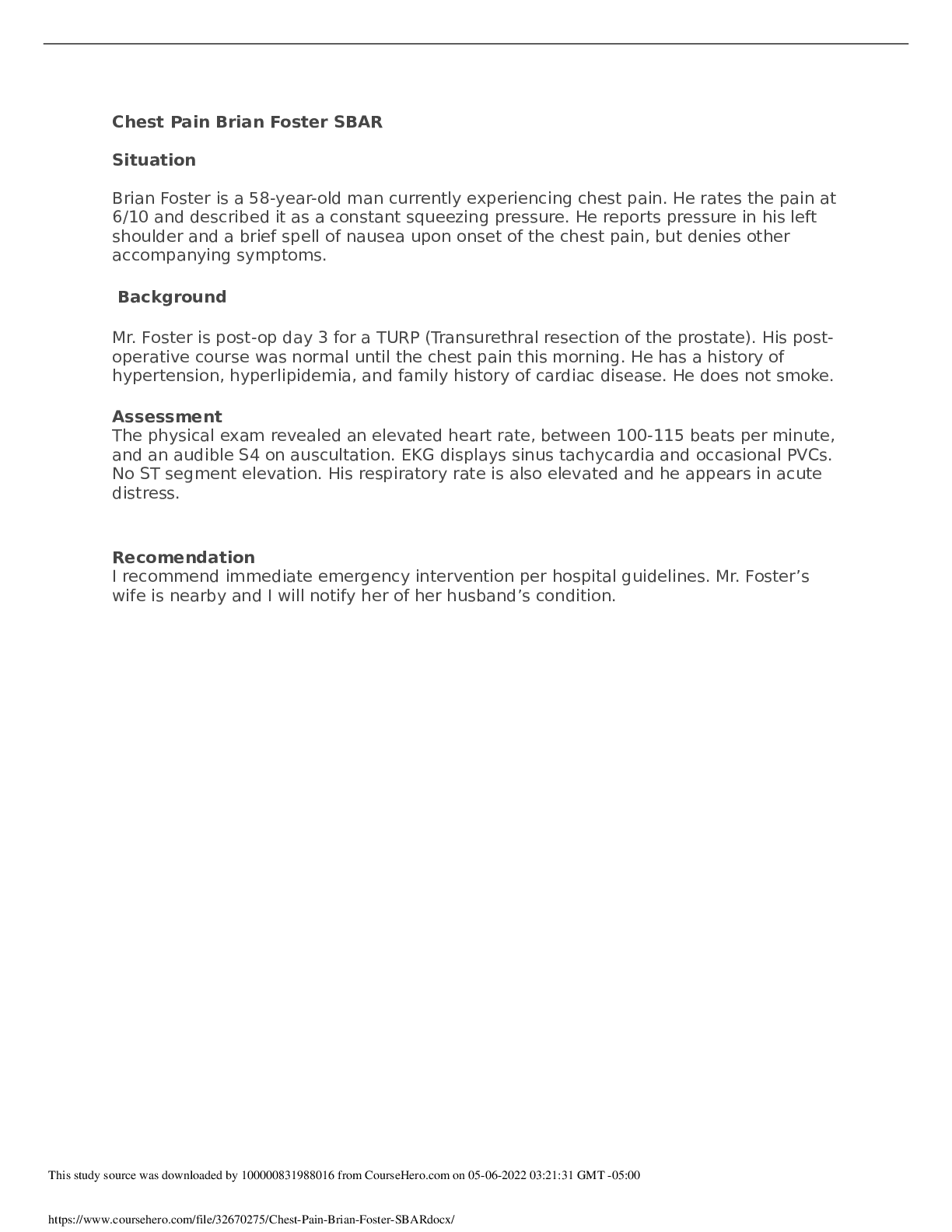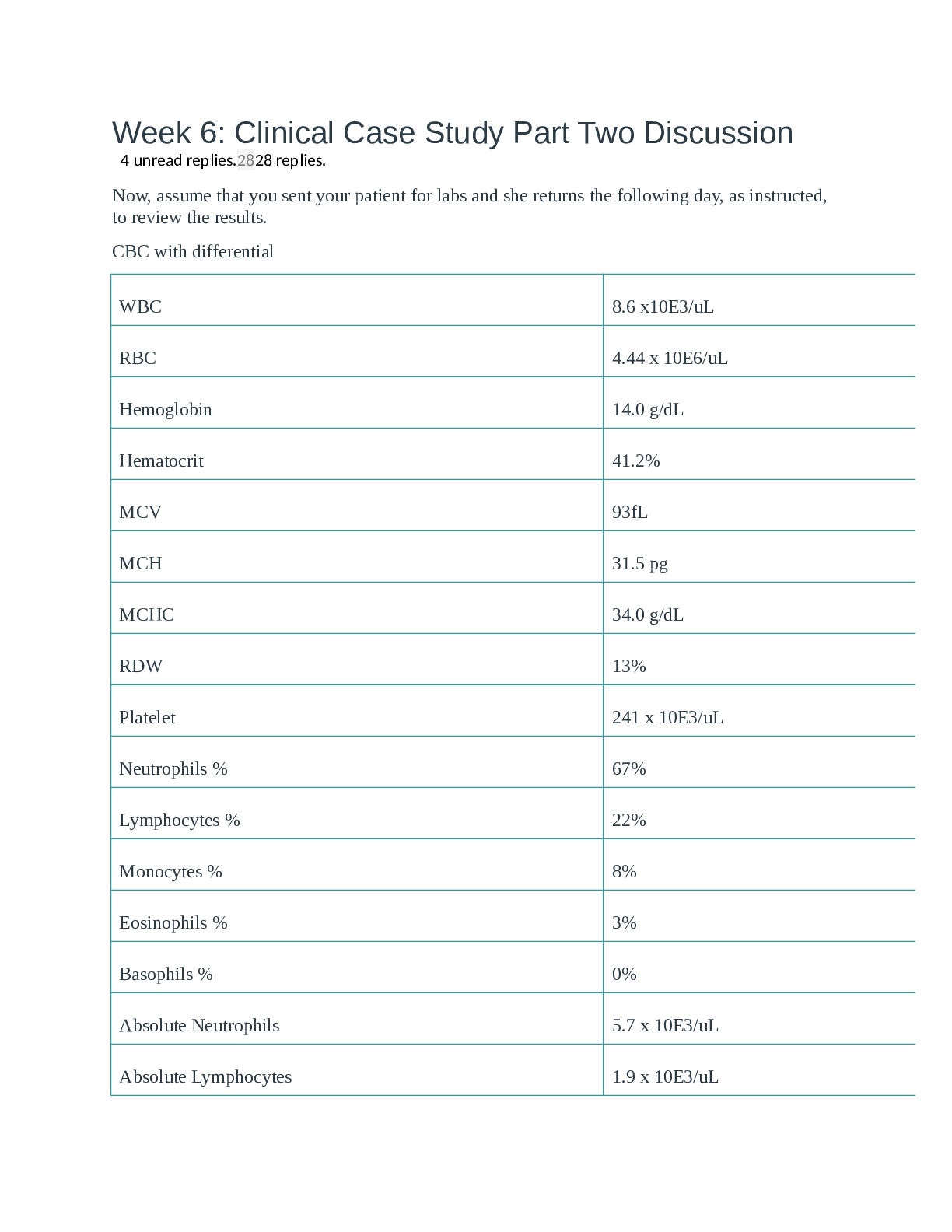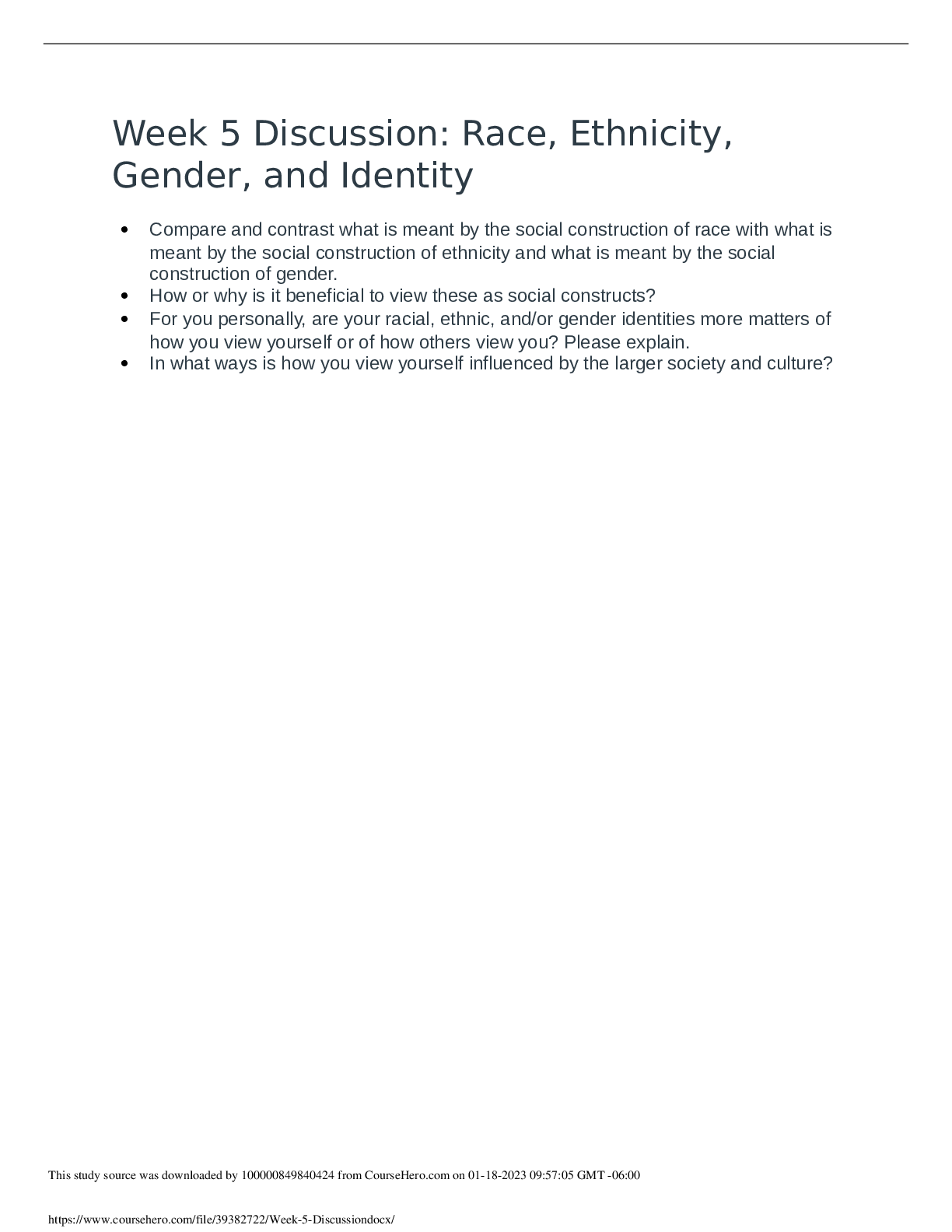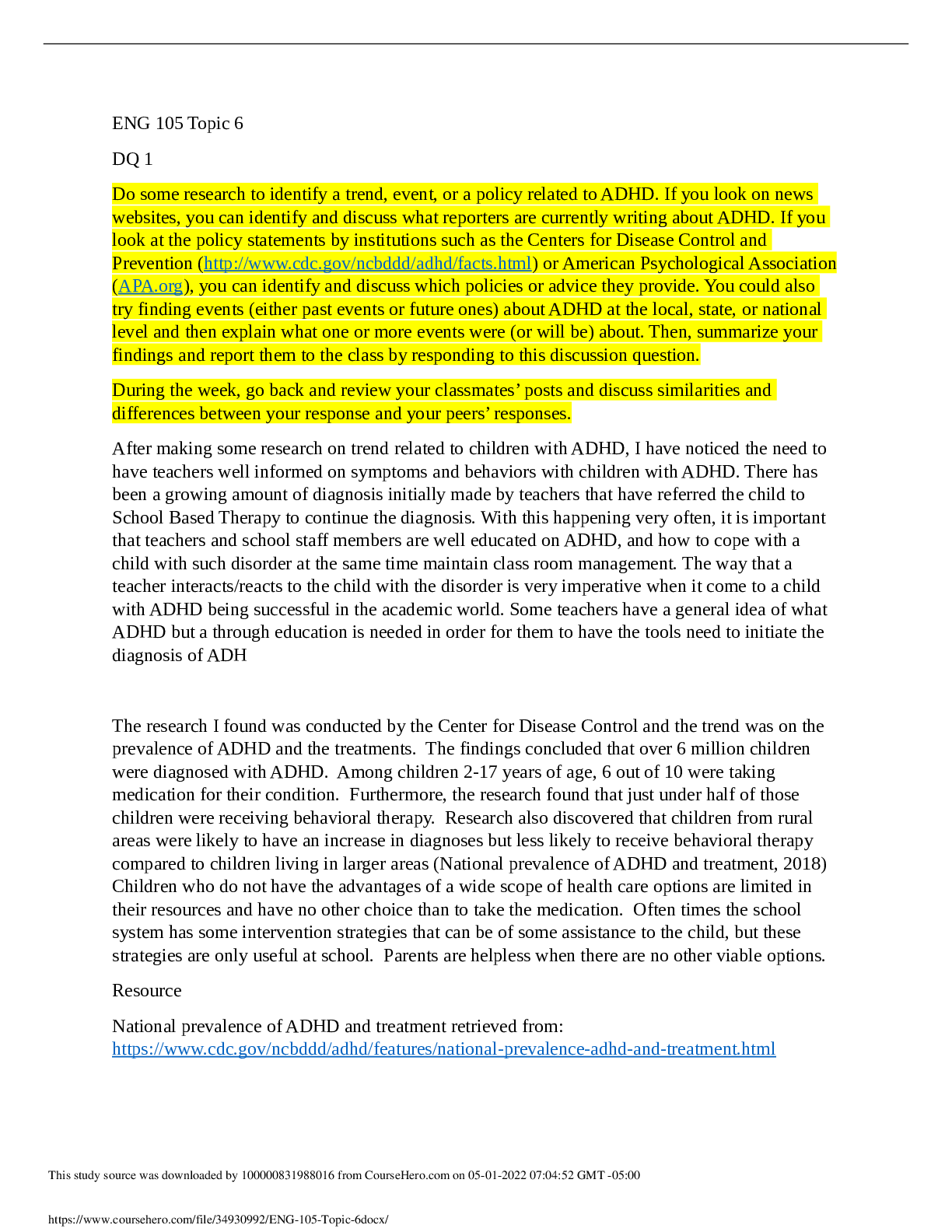*NURSING > CASE STUDY > Antepartum Care UNFOLDING Reasoning ; Anne Jones is a 17-year-old (complete case study) (All)
Antepartum Care UNFOLDING Reasoning ; Anne Jones is a 17-year-old (complete case study)
Document Content and Description Below
Antepartum Care UNFOLDING Reasoning Primary Concept Reproduction Interrelated Concepts (In order of emphasis) 1. Nutrition 2. Patient Education 3. Stress 4. Coping 5. Clinical Judgment ... 6. Communication NCLEX Client Need Categories Percentage of Items from Each Category/Subcategory Covered in Case Study Safe and Effective Care Environment • Management of Care 17-23% ✓ • Safety and Infection Control 9-15% Health Promotion and Maintenance 6-12% ✓ Psychosocial Integrity 6-12% ✓ Physiological Integrity • Basic Care and Comfort 6-12% ✓ • Pharmacological and Parenteral Therapies 12-18% ✓ • Reduction of Risk Potential 9-15% ✓ • Physiological Adaptation 11-17% ✓ Copyright © 2019 Keith Rischer, d/b/a KeithRN.com. All Rights reserved. Anne Jones , 17 years old History of Present Problem: Anne Jones is a 17-year-old Caucasian teenager who thinks she may be pregnant because she has missed two periods. Her last menstrual period, she thinks, was about one month ago. She states she had a little bit of spotting last week but didn’t have a “full period”. She complains of her breasts being tender, swollen, frequent urination, and nausea in the morning. This is her first office visit and she is not sure why she feels so crummy but suspects she might be pregnant. Her urine pregnancy test is positive. Her primary care provider orders a prenatal lab panel and a urinalysis. Personal/Social History: Anne is a senior in high school who stands on her feet while working at McDonalds after school. She drinks six colas daily, denies alcohol use, and does not smoke. She takes no medications except for occasional acetaminophen for headaches and ibuprofen for menstrual cramps. Anne is 5’4” (160 cm) and weighs about 105 lbs. (47.7 kg) according to Anne. A 24-hour recall nutrition history reveals a typical day’s diet: breakfast- pop tart and can of cola; Lunch- a slice of pizza, chocolate chip cookie, can of cola; Dinner- fried chicken, green beans, biscuit, can of cola; snacks, including cookies and can of cola. She broke up last week with her boyfriend, and he is not aware she might be pregnant. She wants to keep the baby but has not told her parents. What data from the histories are RELEVANT and must be interpreted as clinically significant by the nurse? (Reduction of Risk Potential) RELEVANT Data from Present Problem: Clinical Significance: Amenorrhea Positive pregnancy test Breasts being tender, swollen, frequent urination, and nausea Ht. 5”4 (160 cm) Wt. 105 lbs. (47.7 kg) Breakfast- pop tart and can of cola; Lunch- a slice of pizza, chocolate chip cookie, can of cola; Dinner- fried chicken, green beans, biscuit, can of cola; snacks, including cookies and can of cola. Earliest symptom of pregnancy This test checks for the presence of “detectable” amounts of HCG hormone which is secreted by the fertilized egg which is implanted on the endometrium. These are subjective (presumptive) changes, that could indicate pregnancy. This patients BMI is 18, which indicates she is underweight Inadequate intake of nutrients. Lack of prenatal vitamins. At risk for hypertension due to inadequate fluid intake. At risk for gestational diabetes and other health problems associated with diets high in sugars, processed, and fried foods. RELEVANT Data from Social History: Clinical Significance: Patient is a minor, Age 17 She broke up last week with her boyfriend, and he is not aware she might be pregnant. She wants to keep the baby but has not told her parents. Anne is a senior in high school who stands on her feet while working at McDonalds after school This patient is a minor and her parents will need to be contacted in order to provide (legally) further treatment. Patient is alone and does not have emotional support. Also this patient is a risk of experiencing challenges with her education and social wellbeing. Standing on her feet at a laborious job that does not provide adequate health insurance or accommodations for pregnant women may impact her health adversely. Standing for long periods is difficult for pregnant women at risk for DVT. Copyright © 2019 Keith Rischer, d/b/a KeithRN.com. All Rights reserved. Patient Care Begins: Current VS: P-Q-R-S-T Pain Assessment: T: 98.6 F/37.0 C (oral) Provoking/Palliative: Breast tenderness P: 76 (regular) Quality: Tender to touch and movement R: 18 (regular) Region/Radiation: Both breasts BP: 125/80 Severity: 4/10 but better if wears a bra O2 sat: not assessed Timing: For the past couple of months What VS data are RELEVANT and must be interpreted as clinically significant by the nurse? (Reduction of Risk Potential/Health Promotion and Maintenance) RELEVANT VS Data: Clinical Significance: Breast tenderness Changes in the breast are frequently noted in early pregnancy. Engorgement of the breast due to hormone induced growth of the secretory ductal system results in subjective symptoms of tenderness and tingling, especially in the nipple area. The patient is educated about the importance of wearing comfortable bras. Current Assessment: GENERAL APPEARANCE: Calm, body relaxed, no grimacing, appears to be slightly nervous, Height 5’4” (160 cm), weight 100 lbs. (45.5 kg), 5 lbs. (2.3 kg) weight loss from pre-pregnant weight, no appetite. BMI 18 RESP: Breath sounds clear with equal aeration bilaterally ant/post, nonlabored respiratory effort CARDIAC: Pink, warm & dry, no edema, heart sounds regular with no abnormal beats, pulses strong, equal with palpation at radial, brisk cap refill NEURO: Alert and oriented to person, place, time, and situation (x4) HEENT: Normal cephalic, slight bleeding at gum lines. Conjunctiva of eyelids; appears pale Chest: Breasts tender on palpation, areola darkened and occasional veins present Abdomen: Soft; no masses, uterus palpable below the level of the symphysis pubis, Extremities: Mild spider varicose veins on the medial aspect of the left leg, deep tendon reflexes 2+ Pelvic Exam: Vagina and cervix deep purple in color, uterus slightly enlarged, and Hegar’s sign present What assessment data are RELEVANT and must be interpreted as clinically significant by the nurse? (Reduction of Risk Potential/Health Promotion and Maintenance) RELEVANT Assessment Data: Clinical Significance: Low BMI 5 lbs of weight loss Bleeding gums, Tender breast, Dark areolas Uterus palpable below the level of the symphysis pubis LL spider varicose veins, deep tendon reflexes 2+ Deep purple in color, uterus slightly enlarged Low BMI and weight loss is significant because the patient has inadequate nutritional intake and needs supplementation with prenatal vitamins and education about proper caloric increase during each trimester of pregnancy. Objective (probable) changes that occur in pregnancy Chadwick sign, Hegar sign, enlargement of the abdomen, Braxton hicks contractions, uterine soufflé, changes in pigmentation of the skin, fetal outline, pregnancy test. Copyright © 2019 Keith Rischer, d/b/a KeithRN.com. All Rights reserved. Hegar sign Lab Results: Prenatal Panel Hemoglobin RPR/VDRL HBsAG Blood type Rubella HCG ELISA Current: 11.0 mg/dL Negative Negative B- Nonimmune 20,700 mlU/ml Negative What lab results are RELEVANT and must be interpreted as clinically significant by the nurse? (Reduction of Risk Potential/Physiologic Adaptation) RELEVANT Lab(s): Clinical Significance: TREND: Improve/Worsening/Stable: 11.0 mg/dL Rubella (nonimmune) Low hemoglobin is a indication of iron deficiency and places the patient at risk for preterm delivery, anemia, and low birth weight Rubella has teratogenic effects on fetal development, and places the patient at risk for preterm birth. Prevention is possible by vaccination but contraindicated in pregnant women due to the risk of birth defects and preterm delivery Worsening Improve Urine Dipstick Color: Clarity: Sp. Gr. Protein Glucose Ketones Leukocytes/Nitrite Blood Chlamydia Gonorrhea Current: Yellow Clear 1.010 neg neg neg none none positive What lab results are RELEVANT and must be interpreted as clinically significant by the nurse? (Reduction of Risk Potential/Physiologic Adaptation) RELEVANT Lab(s): Clinical Significance: Chlamydia Gonorrhea during pregnancy(+) Chlamydial infection is the most frequently reported infectious disease in the United States, and prevalence is highest in persons aged ≤24 years (118). Several sequelae can result from C. trachomatis infection in women, the most serious of which include PID, ectopic pregnancy, and infertility [Show More]
Last updated: 2 years ago
Preview 1 out of 10 pages
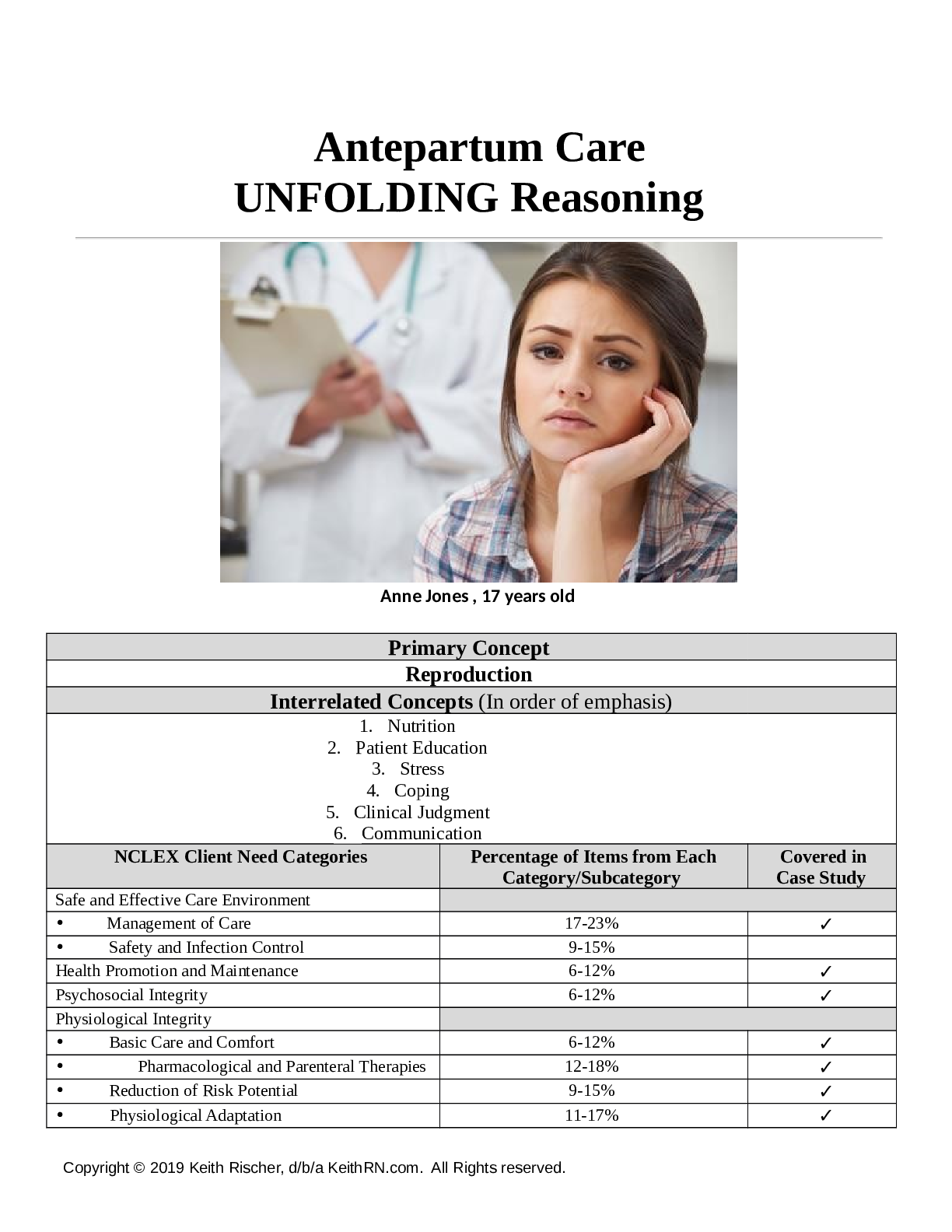
Buy this document to get the full access instantly
Instant Download Access after purchase
Buy NowInstant download
We Accept:

Reviews( 0 )
$12.00
Can't find what you want? Try our AI powered Search
Document information
Connected school, study & course
About the document
Uploaded On
Sep 19, 2021
Number of pages
10
Written in
Additional information
This document has been written for:
Uploaded
Sep 19, 2021
Downloads
0
Views
128




